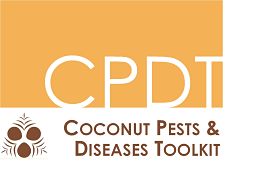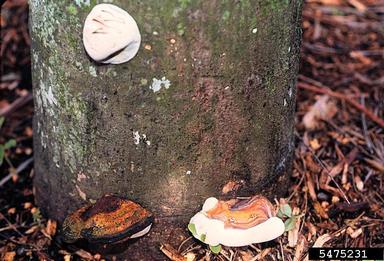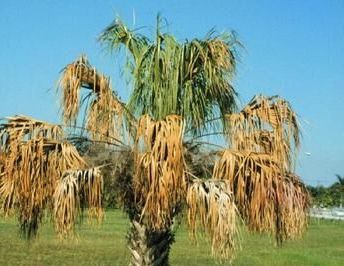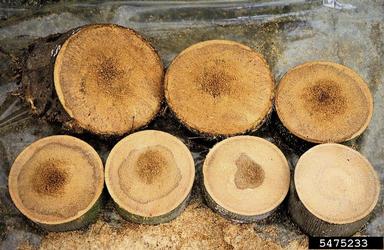Ganoderma butt rot
Ganoderma butt rot is a fatal disease caused by a fungus. This is a HIGH risk disease.
Ganoderma butt rot is caused by a wood-decaying fungus called Ganoderma zonatum. There are other Ganoderma species already present in the Pacific Islands that can only attack very weakened or old palms. Ganoderma zonatum is the only species known to attack vigorous living palms.
Ganoderma zonatum is the main cause of butt rot, and this is not present in the Pacific. However, Ganoderma identification has been uncertain and only recently has the genus been studied with molecular tools. One such study has found Ganoderma zonatum in oil palms in Malaysia.
Common name of the diseaseGanoderma butt rot |
Scientific name of the cause of the diseaseGanoderma species usually Ganoderma zonatum |
on this page: Life-cycle and identification : Symptoms : Impacts : Distribution : Prevention : Controlling Ganoderma butt rot : Information sources and further reading
Life-cycle and identification
The fungus causes the lower part of palm trunk to break down. However, it does not cause soft rot of the wood. The fungus can become visible towards the end of disease development when it produces a rounded hard structure (called a basidiocarp or conk) on the lower part of the trunk (up to 1-1.5 m from the ground). This is a useful feature for diagnosing the disease. However, other Ganoderma species also produce very similar structures when they attack weakened or old palms.
|
The fungus initially grows inside the trunk, and then protrudes outwards. There are three visible phases to the basidiocarp (conk) formation;
Basidiocarps will grow to fit the size of their host but can be about 20 cm wide and 5 cm thick. Up to three cups of tiny creamy-white, oblong ellipsoid spores (basidiospores) are released from the underside of basidiocarps. |
The three stages of the basidiocarp (conk) formation (© Monica Elliott, USDA APHIS ITP, Bugwood.org) |
The Ganoderma spores may be visible as a brown-red rust. Spores that come into contact with the soil will grow into fungal threads that cover the roots of the palm and spread up the trunk
Symptoms
The crown of the palm will become mildly to severely wilted or there may be fewer fronds compared to healthy palms.
Growth of the crown may slow and the lower leaves may look dead or discoloured.
|
Crown of a palm showing wilted fronds and dead lower leaves (© Monica Elliott, USDA APHIS ITP, Bugwood.org) |
Discolouration on the insides of cut trunks from Ganoderma butt rot(© Monica Elliott, USDA APHIS ITP, Bugwood.org) |
The defining feature for diagnosing Ganoderma infection is the basidiocarp (conk) on the lower part of the trunk (up to 1-1.5 m from the ground).
The basidiocarp (conk) may form before the death of the infected palm but this is not always the case.
If no basidiocarp is present after death, look for discolouration of the insides of the lower part of trunk when cut down.
Spores may be visible as a brown-red rust.
Fungal threads may be visible covering the roots of the palm making its way to the trunk.
Impacts
Ganoderma zonatum is lethal to coconut palms, and it can cause major losses to plantations. Areas that become infected may not be suitable for ongoing planting and production as the soil may be carrying the fungus.
Distribution
Please check with your local biosecurity / quarantine or SPC for up-to-date distribution information.
Ganoderma zonatum occurs throughout Southeastern USA, primarily Florida, but also in Georgia and South Carolina. The fungus is also known from oil palms in south-east Asia.
Prevention
Most importantly, the International Guidelines for transfer of coconut germplasm should be strictly followed to prevent pests and diseases being moved to new locations.
As Ganoderma zonatum is not present in the Pacific, and it is lethal to coconut palms, prevention is important.
Transport of palms from the Southern United States should be prohibited.
There is no way to tell if a newly planted palm is infected with the fungus until the basidiocarp forms or death occurs. There is also little knowledge on the duration of the fungal infection from initial infection to death. Therefore, it is very hard to control the spread of Ganoderma zonatum.
There is no certain connection between environment or palm health and the development of the infection. This makes it very hard to create control or management practices. However, mechanical wounds on the trunk may increase the likelihood of the fungus entering the trunk.
The fungal spores can be easily transported by water and wind, therefore the late identification and/or removal of infected palms can result in the disease being spread prior to detection.
Ganoderma infection may be mistaken for lethal yellowing of palms caused by phytoplasmas. Ganoderma and phytoplasmas require different methods of treatment. Therefore, misdiagnosis as phytoplasma infection may lead to the movement of infected palms and spread of the fungal spores.
For general information on preventing pests and diseases of coconut, see the Prevention section.
Controlling Ganoderma butt rot
The control and management of Gandoderma butt rot is difficult. However, there are methods to prevent spread once the palm has been diagnosed.
When cutting an infected tree down, the lower section should be burned or placed in landfill (not within the production landscape) and not used as mulch or chip as this will spread the spores.
Monitoring of basidiocarp growth on palms including removal of stumps is very important as the basidiocorps can release millions of spores which can cause further infections. This will help reduce the spread of the fungus especially in the early stages of development (white button or mushroom like growth) before they are released.
Let the community know of infected areas so they too can monitor plantations as the spores can be easily transported.
When planting palms, plants should be spread widely to reduce the risk of infection through root spread. Sites that have become infected should be left and ploughed for several years before replanting. Even in areas where the rot has not been observed, monitoring every six months is recommended.
Information sources and further reading
Elliott, Broschat. 2001. Pathogenicity Experiments on Ganoderma zonatum in Florida. Palms, 45, 2, 62-72
Elliott, Broschat. 2018. Ganoderma Butt Rot of Palms. Plant Pathology Department, 54, 1-5
Idtools. 2015. Ganoderma butt rot. [ONLINE]
Plant Village. 2018. Coconut; Diseases and Pests, Description, Uses, Propagation. [ONLINE]
Rashid, Choon-Fah, Bong et al. 2014. Genetic and morphological diversity of Ganoderma species isolated from infected oil palms (Elaeis guineensis). International Journal of Agriculture and Biology. [ONLINE]
Zhou et al. 2015. 2015 Global diversity of the Ganoderma lucidum complex. Phytochemistry, 114, 7–15
content reviewed by Richard Davis, Northern Australia Quarantine Strategy, Department of Agriculture and Water Resources, July 2018



